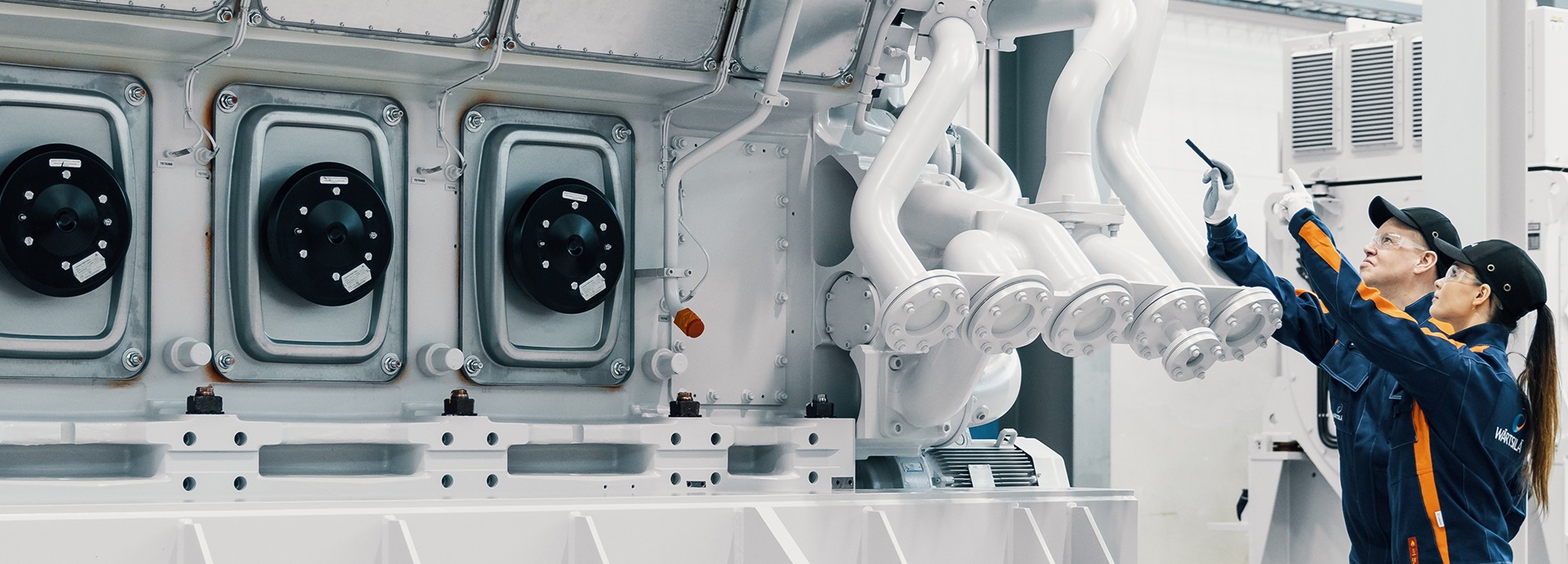

Are you looking for solutions to reduce your methane slip? Dramatic improvements are possible with the right insights and technology. Discover seven helpful and unbiased facts that can bring results – fast.
If your vessel uses liquified natural gas (LNG) as fuel, there’s always a small amount that doesn’t burn in the engine and escapes with the exhaust gases instead. This is known as methane slip – a challenge that engine manufacturers have been working on for years. Here are the essential facts you need to know about methane slip and how you can reduce it in your operations.
Can LNG help with decarbonisation?
Fact 1: LNG has significant potential to cut emissions
Sustainable fuels hold the key to cutting emissions from shipping. To reach the IMO’s 2050 greenhouse gas (GHG) emissions targets, LNG offers great potential as a natural bridge between traditional fossil-based marine fuels and sustainable clean fuels. There are four main reasons for this:
- LNG can reduce emissions. LNG emits up to 25% less GHG tank-to-wake (TtW) and up to 15% less well-to-wake (WtW) emissions compared to traditional marine fuels for the same propulsion power. LNG also cuts NOx emissions by around 90% and almost completely removes SOx and particulate emissions.
- LNG is adaptable and proven. There are over 1,300 vessels in operation that can use LNG as fuel, with another 1,000 vessels on the orderbook.
- LNG is widely available. There are over 200 active LNG bunkering locations around the world.
- LNG engines are future-proofed. LNG-capable engines can be converted to run on 100% carbon-neutral fuels when it’s time to switch.
Bio-LNG, which is LNG produced from organic waste or biomass, offers an even more sustainable alternative to fossil-based LNG. Bio-LNG can be used as a drop-in fuel in all LNG engines without any changes.
Does burning LNG release methane?
Fact 2: Burning LNG releases methane – a greenhouse gas – into the atmosphere
LNG is predominantly methane, and methane is an extremely powerful greenhouse gas. If your vessel’s engines burn LNG as a fuel, most of the methane will be used up in the energy conversion process. However, some of the methane remains unburned and escapes into the atmosphere. This is known as methane slip. It is important to minimise the amount of methane slip in vessels that burn LNG as fuel.
There are also upstream methane emissions from the production and transport of LNG. If not addressed, these methane emissions reduce the climate-related advantages of LNG.
Can reducing methane emissions help to tackle climate change?
Fact 3: Cutting methane emissions will help us slow climate change
Methane is the second most abundant greenhouse gas after carbon dioxide and it remains in the atmosphere for about a decade. While this is a much shorter lifetime than carbon dioxide, cutting methane emissions is the most effective way to slow climate change over the next 25 years. Cutting methane emissions also complements ongoing efforts to reduce carbon dioxide emissions.
The good news is that technology is available to reduce methane slip significantly.
What causes methane slip in gas engines?
Fact 4: There are three main sources of methane slip
Although a lean-burn LNG engine will use up most of the methane in the fuel during the energy conversion process, some methane remains unburned. There are three main sources of unburned methane in maritime engines:
- Flame quenching in crevices – the amount of methane slip from this source tends to remain constant regardless of engine load.
- Flame quenching in the bulk charge – the amount of methane slip from this source varies by engine load, with higher loads resulting in less methane slip.
- Scavenging losses – the amount of methane slip from this source tends to remain constant regardless of engine load.
Can you minimise methane slip in an existing vessel?
Fact 5: You can minimise methane slip in both existing and newbuild vessels
If you already own or operate a vessel with dual-fuel engines that burn LNG, you should do everything possible to cut methane slip. This could be upgrading your engines or reducing your fuel consumption – after all, the greatest emissions savings come from the fuel you don’t use.
For owners looking to minimise methane slip in a newbuild vessel, the key is to design with flexibility and the future in mind. Ideally you should:
- choose a dual-fuel engine for fuel flexibility so your vessel can adapt to different circumstances
- select latest-generation engines with a modular design and low emissions
- design your vessel to avoid low loads with batteries for energy storage
Modern dual-fuel engines can significantly reduce methane slip – for example, Wärtsilä has cut methane slip from its dual-fuel engines by more than 90% compared to 1993 levels. Choosing a NextDF engine can reduce methane slip even further, to around 1% of fuel use – a figure well below the FuelEU Maritime regulation of 3.1% of fuel use. NextDF engines significantly reduce emissions while still providing the same high power output as before.
- Find the facts on the Wärtsilä 31DF and its NextDF feature
- Find the facts on the Wärtsilä 25 and its NextDF feature
- Find the facts on the Wärtsilä 46TS-DF and its NextDF feature
The webinar How to reduce methane slip – winning tactics for your maritime business shares five powerful ways to reduce methane slip:
- Keep your vessel well maintained.
- Avoid operating at low load.
- Reduce the power needed for propulsion.
- Optimise your engines.
- Design your newbuild vessel with flexibility in mind.
Watch the full webinar recording to learn more about each of the five winning tactics.
A quick and easy upgrade to your existing engines could cut methane slip by up to 65% depending on the engine type and load. Learn more: How to reduce methane slip from LNG engines.
Whether you’re looking to minimise methane slip in a newbuild or an existing vessel, this white paper can help you reduce your fuel bill by ensuring your engines run at optimal load: How to spend less on ship fuel and make amazing savings every sailing. Running your engines at optimal load ensures they are at their most efficient, use the least amount of fuel and emit the least emissions.
Does reducing methane slip have to involve a lot of costly engineering work?
Fact 6: Reducing methane slip doesn’t need to be costly or complicated
It might surprise you to learn that addressing methane slip in LNG-powered ships does not need to involve lots of time-consuming and expensive engineering work. If your vessel is already powered by a Wärtsilä dual-fuel engine, one field service technician and their laptop could be all that’s needed to reduce your methane emissions.
Hand-picked content: How the Wärtsilä 34DF control software upgrade cuts greenhouse gas emissions
The software upgrade – which is available for Wärtsilä 20DF, 34DF, 46F-DF and 50DF dual-fuel engines – works by marginally reducing the engine’s charge air pressure and lambda – the air-fuel ratio in the combustion chamber. The upgrade is quick and easy to install and can cut methane slip by up to 60% when your engines are operating in gas mode below 85% load. This will take your engines well below the current EU requirements for methane emissions.
Is there any IMO methane slip regulation?
Fact 7: There will be more methane slip regulation in future
In early 2025 the International Maritime Organization (IMO) Marine Environment Protection Committee (MEPC) 83 meeting approved mid-term greenhouse gas reduction measures as part of the IMO Net-Zero Framework. These measures include a global marine fuel standard and an emissions pricing mechanism – the first global carbon fee in the maritime industry.
The IMO regulation mandates a gradual reduction in the GHG intensity of maritime fuels, addressing emissions on a well-to-wake basis. Both methane slip and nitrous oxide are included in the measures. The regulation is set to enter into force from March 2027 and will come into effect from the beginning of January 2028 for all ships over 5,000 gross tonnage that trade internationally.
In Europe, the EU Emission Trading System (ETS) was extended in January 2024 to all ships of 5,000 gross tonnage and above that enter EU ports. This means that ship owners must pay for their greenhouse gas emissions when sailing into, out of or between EU ports. The EU ETS currently only covers CO2 emissions on a tank-to-wake basis, but from 2026 methane and nitrous oxide emissions will also be included.
Hand-picked related content:
How to understand the EU Emissions Trading System and save money
FuelEU Maritime came into force in January 2025. This regulation mandates gradual reductions in the greenhouse gas intensity of fuels used by ships, addressing emissions on a well-to-wake basis, including methane. Non-compliance could leave ship owners and operators to face costly financial penalties.
Ready to reduce your emissions while powering the ships of tomorrow? Take a look at the bigger picture and discover 51 great ways the maritime industry could reduce its greenhouse gas emissions.
Related solutions
Did you like this? Subscribe to Insights updates!
Once every six weeks, you will get the top picks – the latest and the greatest pieces – from this Insights channel by email.





